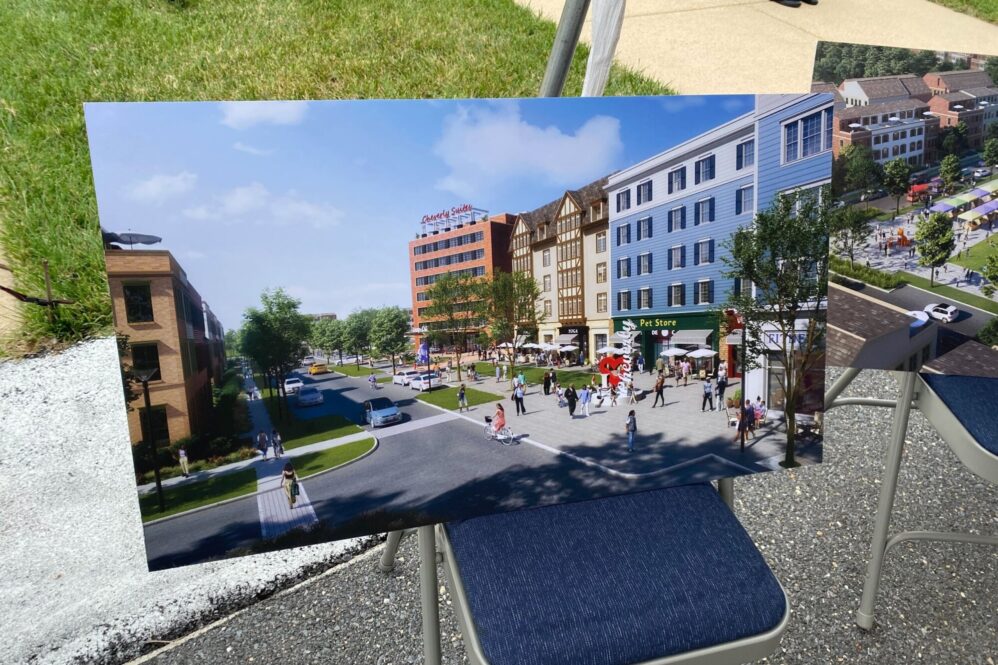The town of Cheverly, Maryland, and its roughly 7,000 residents have a unique and proud community, but their beloved hometown doesn’t have a downtown, let alone a proper coffee shop. But there are plans to change that and bring much more.
Tucked mostly between U.S. Route 50 and the Baltimore-Washington Parkway as they converge on the D.C. line, Cheverly residents love to live there, even though the town does not have all of the amenities that many communities have.
On Wednesday, Prince George’s County leaders stood in front of the old Prince George’s County Hospital Center, which is considered part of Cheverly.
If you want to get technical, it’s actually outside of the town’s boundaries — but maybe not for long. Town leaders are talking about annexing the land as a massive redevelopment project gets started.
“We started off as a solid, ‘No, we weren’t annexing,’” Cheverly Mayor Kayce Munyeneh said. But talks with county leaders about what the redevelopment of the property could bring turned that into a gentle “it makes sense” and then “it only makes sense that it’s part of our community and not just that we’re neighbors,” Munyeneh said.
The land the old hospital sits on is the highest point in all of Prince George’s County, and the vision for the 44-acre property includes more than 1,100 new residential units — comprising apartments, townhomes and senior living space — to go with restaurants, retail, outdoor space and other entertainment options. These are all amenities that Cheverly currently lacks.
“One of the things we don’t have in Cheverly is a coffee shop,” Munyeneh said.
“We all walk to the 7-Eleven to get something to drink. We don’t have a downtown. We have a wonderful community. We have a Cheverly market. But someplace to shop?
“I think this could be our downtown Cheverly, with a Main Street,” Munyeneh said.
Retail, restaurants and even a hotel are in the works, and although it sits along Maryland Route 202 and right between two of the busiest highways in the region, this won’t be a car-dependent development.
“Development plans for this project include direct trail connections to both the Anacostia Trail network and the Cheverly Metro Station,” Prince George’s County Executive Angela Alsobrooks said.
“It’s literally just a matter of having a path because it’s (the Metro station) less than a mile that way,” Munyeneh said, pointing to trees along the border of the hospital’s property. “The Metro use is so important. Cheverly is the most underused Metro in the entire station system.”
Also important is the hill used by residents in the area for sledding. Those who grew up in the area pointed out how important Hospital Hill was, and how it is vital that future kids would still be able to count on using that hill for snow-day thrills.
Unique funding behind the project will bring huge investment possibilities.
During the news conference Wednesday, Alsobrooks said that the redevelopment plan can become a national model for other localities to follow.
“It will allow our residents to take ownership in this location’s renewal,” Alsobrooks said.
There be a high percentage of minority participation in the redevelopment process, and some of the funding will be crowdsourced on platforms such as Crowdstreet.
“An astounding 40% of sponsor equity in this project will be targeted to minorities and local businesses and individuals,” Alsobrooks said.
That means tens of millions of dollars will be raised and invested by a mix of people and businesses, regardless of whether they live there or are involved in construction.
“Typically those kinds of investment opportunities are only available to investors of a certain size,” said Caroline Kenney, managing director of public-private partnerships with Urban Atlantic.
“Typically a local resident from the town of Cheverly would not have the opportunity to invest in a project like this because you need to be at a certain size and a certain threshold. This is designed to lower that bar to make sure we’re able to pull in as many local and minority folks as possible.”
The final details about how that will work — including how much money will be needed to become an investor — haven’t been worked out yet. But it will only be open to county residents and businesses, who then figure to make money off their investment like any other developer, or, as someone does when buying stock in a publicly traded company.
“As the project makes money over time, distributions are made” to the investors, Kenney said. “Just like a return on investment typical to what people see when they invest in stock but they happen to be investing in their own backyard.”
A lot of the behind-the-scenes work and planning are underway, and the actual demolition of buildings and land could begin either later this year or sometime next year.
In the long term, the entire project might take a decade or so to complete. It is expected that the transformation will be well underway within four to five years.
This article was written by WTOP, read more articles like this here.
Photo: The town of Cheverly, Maryland, doesn’t have a proper coffee shop, but there are plans to change that and bring much more. (WTOP/John Domen)










